As I mentioned in a preivous post, I am growing three different types of winter squash this year. The three photos below show the three different types: spaghetti squash (first photo), butternut squash (second photo), and sugar pie pumpkins (third photo).
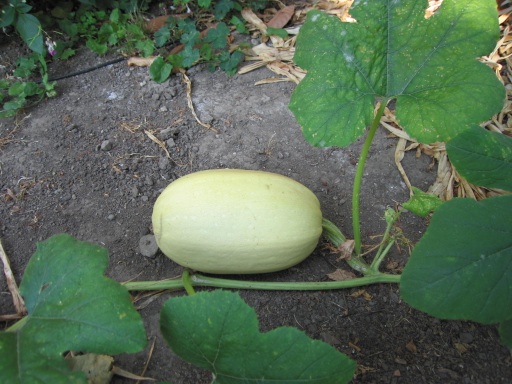
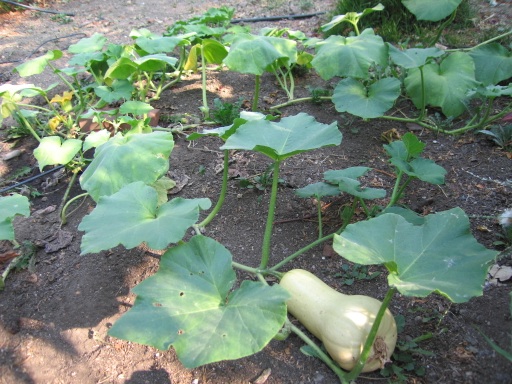
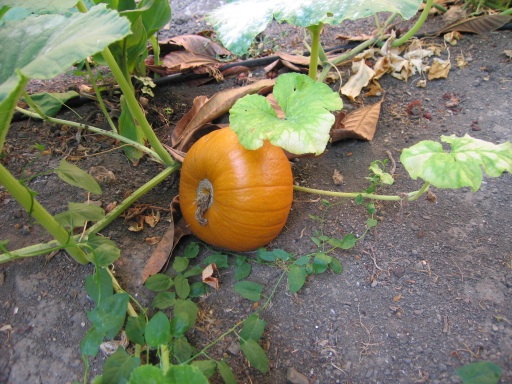
I am growing winter squash directly in our dry clay soil. I added compost in a few of the holes when I planted the seeds, but the plants that got planted with compost are not growing any better than the ones that did not. I am watering each group of plants near their roots almost everyday with automatic microsprayers. Regular water seems to be critical to getting winter squash to grow long vines and large fruits. Everyday when the vines are exposed to direct sunlight for several hours, the leaves droop down. Watering doesn’t make the leaves perk up until the vines are shaded again. Other than lots of water, our winter squash doesn’t seem to need much care. I have not fertilized them. But because our soil is so dry, I don’t need to be concerned about the fruits rotting on damp soil.
Some people have commented that winter squash takes up too much room, because the vines can grow to 10 feet or more. I am growing winter squash in between our fruit trees. The vines grow around the fruit trees, and so they don’t take up much additional garden space. Although I have to be careful not to step on the vines when picking fruit.
August 01 2013 | Pumpkin and Squash | Comments Off on Winter Squash
We grow over a dozen different kinds of fruit trees and berries in our yard, including apricots, apples, figs, plums, pears, pluots, peaches, cherries, oranges, blackberries, strawberries, blueberries, and raspberries. Not all of our fruit trees produce fruit every year, and each type of fruit has a limited season. But because we have so many fruits, we typically have fruit to eat from our yard from May through September. Most of the fruit production occurs in our yard in mid-summer, so we have an abundance of fruit in the months of July and August.
This week, I have been harvesting Elephant Heart plums from our multi-grafted plum tree, shown in the photo below. The skin of these plums can be quite sour, at least until the fruit is almost mushy, but the pulp has a nice flavor.
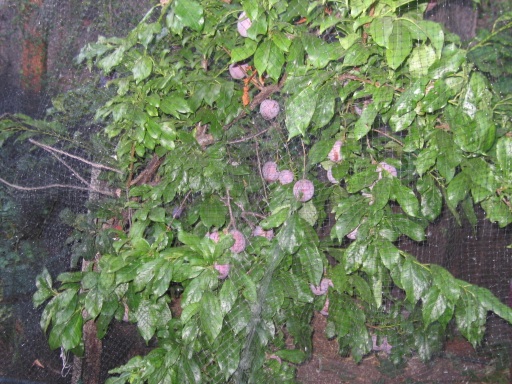
Our small Bartlett pear tree is loaded with at least 100 pears this year (photos of it below). I have picked over 30 pears from it already, but I’ve not eaten any of them yet. Pears are harvested while still green and unripe. They are ready to harvest if the fruit separates from the branch easily when the fruit is lifted by hand into a horizontal position. The pears from this tree have been exquisite in past years. Although, our tree typically only produces pears every other year.
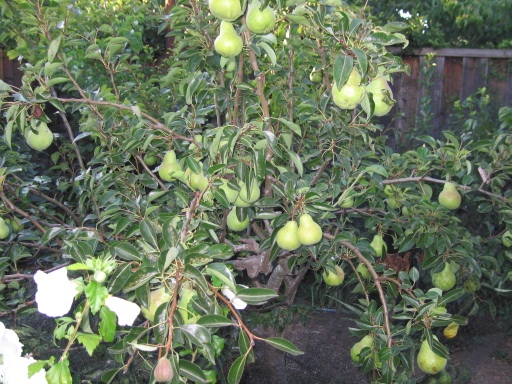
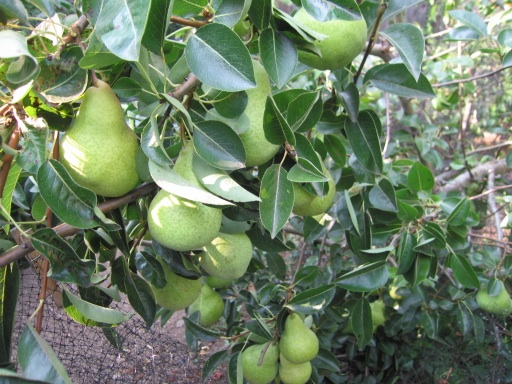
I am also harvesting Flavor King and Dapple Dandy pluots from our multi-grafted pluot tree. The first photo below is Flavor King (purple fruit), and the second photo is Dapple Dandy (pink fruit). I’m supporting the thin branches of this small tree with tomato cages, because there is too much fruit even after I thinned them. Also, the fruit is large (larger than last year’s harvest). I also have to protect them and my other fruit with netting.
Our pluot tree is one of my favorite fruit trees. Its fruits are delicious. Flavor King is perhaps one of the tastiest fruits I have eaten, even though plums in general are not my favorite fruit. Each of the 4 pluot varieties on our tree is unique in terms of its color, flavor, ripening time, and keeping quality. The other two varieties are Flavor Queen and Flavor Supreme. Dapple Dandy is a good variety, because it produces a lot of fruit, and the fruit holds well on the tree for several weeks.
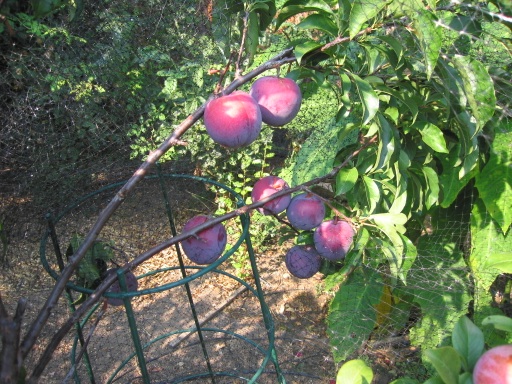
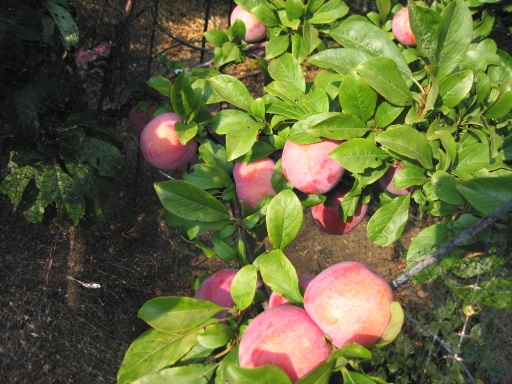
We also have a Caroline red raspberry plant that is growing in a large pot. Its canes are full of luscious looking raspberries right now, as shown in the next photo below. Unfortunately, our raspberries are not edible, because the insides of the berries are full of insect larvae that resemble very small white worms. Nearly all of the berries I have picked in the past week are full of the worms, and it’s not practical to remove them all. Although they may not be harmful if consumed, they are not appetizing.
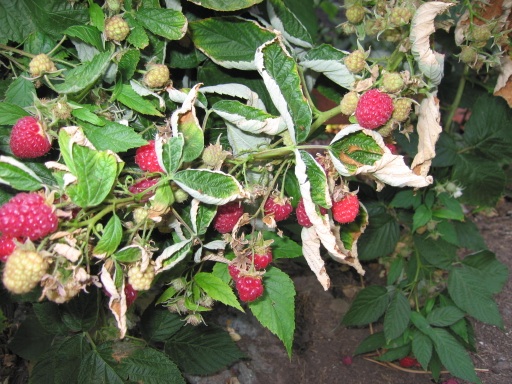
July 29 2013 | Pears and Plums and Pluots and Raspberries | Comments Off on Mid-Summer Fruit
I harvested our first corn ears of the 2013 season today. The kernels on the ears were fully formed, although some of the kernels were too plump from being left on the stalk a few days too long. Here is a photo of them:
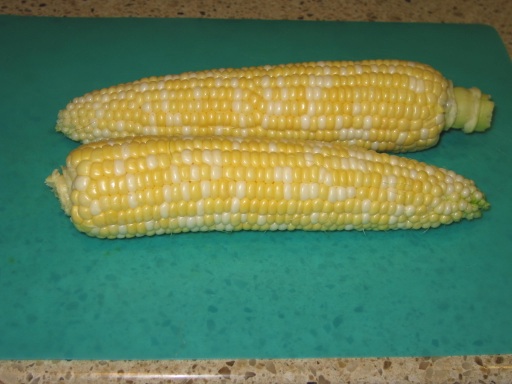
One of our corn stalks is a mutant. It has 3 corn ears on it, as seen in the next photo, which is the most I have ever seen on a single stalk. This stalk even grew suckers that also appear to be generating their own ears of corn. Typically, each stalk only produces one or two ears at the most.
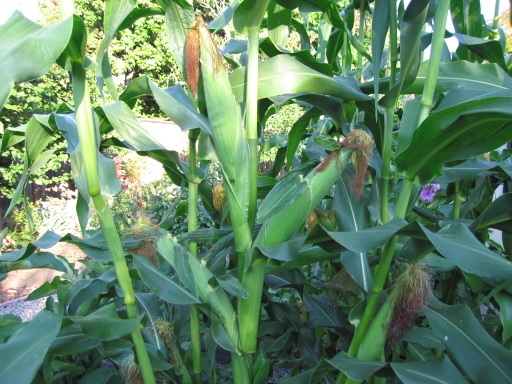
Here are more photos of the same corn patch. Many of the stalks have one or two large plump ears already. I planted these corns by seed in early April and have given them little extra care or fertilizer since then other than regular watering with an automatic micro-spary system. I planted the seeds very close together about 12 inches apart in three rows. Most of the stalks have grown to their full height, but a few of the stalks that sprouted later got crowded by the others and did not reach their full heigth. The stunted stalks tend to produce small ears or none at all.
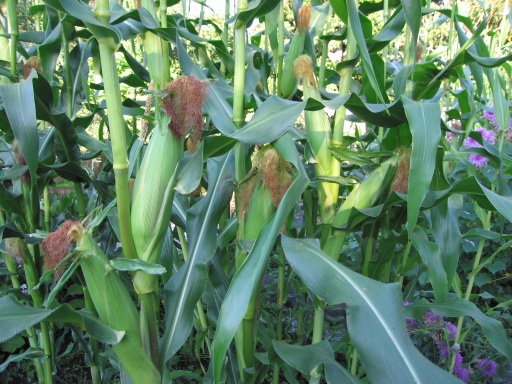
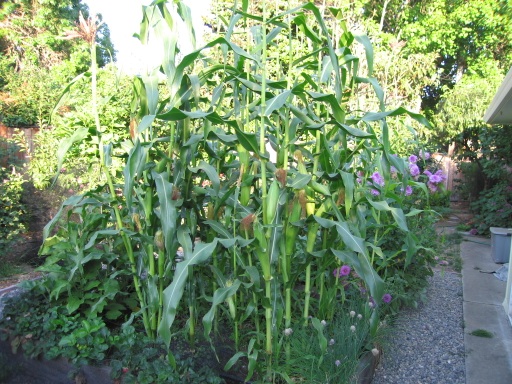
July 23 2013 | Corn | Comments Off on Mutant Corn
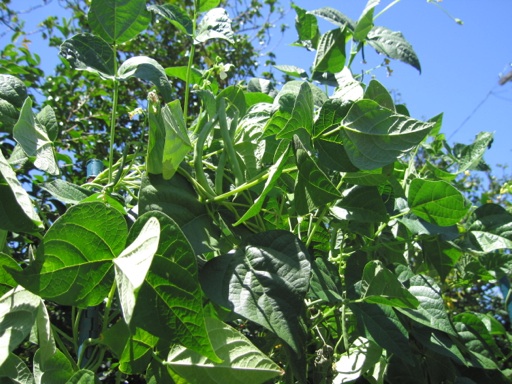
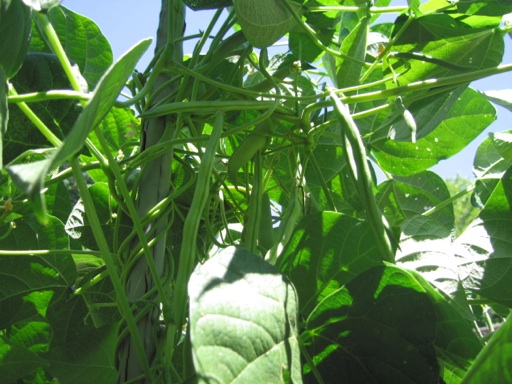
The blue lake beans I planted in March have produced a large amount of beans since late May. I have been picking at least a pound of them about twice per week. Most green beans can get tough and stringy if left on the vine too long. I pick my beans while the bean pods are still slender and the bean seeds inside the pods are not visibly bulging so that we can eat them while they are still tender. After the bean seeds start to get fat and the individual bean seeds inside the pods are distinguishable, they are usually too tough. After bean flowers bloom, the bean pods grow rapidly to full size in about a week. In order to get as many beans as possible while they are still tender but not too small, I have been picking them about twice per week and throwing away the ones that are too fat. I do miss a lot of them, because many are hidden among the leaves.
June 29 2013 | Beans | Comments Off on Prolific Green Beans
Last March around the first of spring, I planted blue lake pole bean seeds and light and dark green zucchini seeds directly into one of our raised beds. I stared harvesting green beans and zucchinis in late May, and they have been producing prolificly since then. This year is the earliest harvest I’ve ever had for beans and zucchini. In the past, my green beans and zucchini didn’t mature until mid-June, and I have always planted them at the same time around the first day of spring. This year’s warmer weather was likely the cause.
Below is a photo of one of my raised beds that has pole beans growing on a wire support in the back, tomatoes in the middle in square cages, zucchini up front, and strawberries growing around the edge. This is the same bed shown in my Apr. 20 post. The plants are close together, which helps to prevent weed growth.
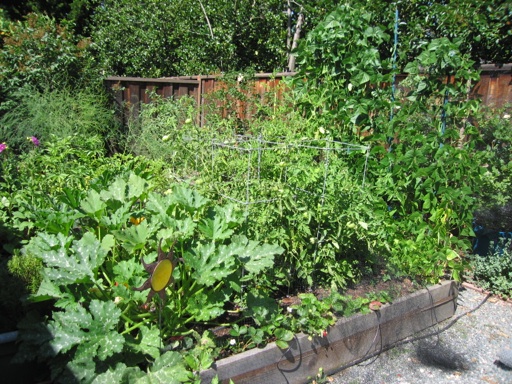
This is a close up photo of one group of my zucchinis:
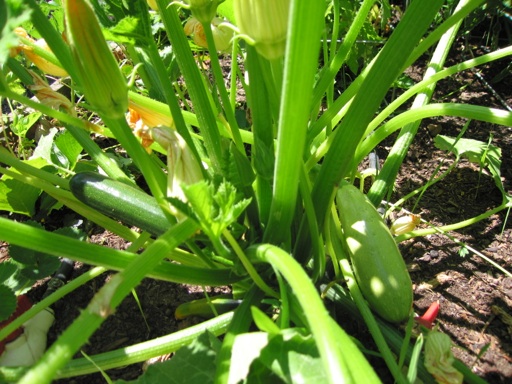
My corn plants are also precocious this year. I planted corn by seed on Apr. 8 directly into another raised bed. The corn seeds took 2 weeks to sprout, but it has been growing rapidly since then. They already are pushing out the tassels.
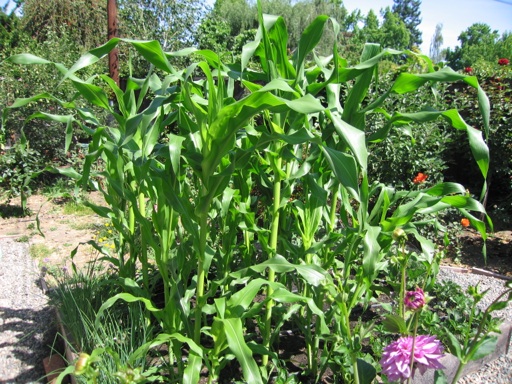
I am experimenting with growing some new edible plants this year. Peanuts are one of the new plants I am growing this year. Peanuts are supposed to thrive in warm summers. I’m not sure it will be warm enough for them here, but I think that it will be fun to try at least once. I purchased peanut seeds through an online mail order website. I planted the peanut seeds in late April. The seedlings look like little pea plants. They are already generating small yellow sweet pea-like flowers. The photo below shows what they looked like earlier today.
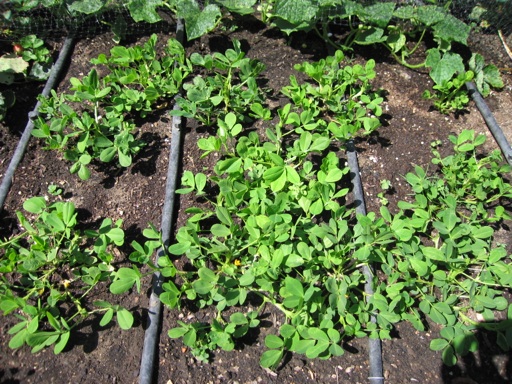
I am also growing spaghetti squash, butternut squash, and sugar pie pumpkins this year for the first time. I planted all of these by seed. I planted the spaghetti squash and pumpkin seeds in late March outdoors in small pots and then transplanted them into the ground after they had sprouted. I decided not to plant them in our raised beds, because their vines grow so long that they would grow out of the beds and along the paths around the beds, which would force me to constantly step over the vines.
Our natural soil here is clay. Our neighbors grew pumpkins successfully in their clay soil last year, which inspired me to try them this year. The spaghetti squash and pumpkin vines are already several feet long and growing rapidly. The photo below shows two spaghetti squash vines with two spaghetti squash on them.
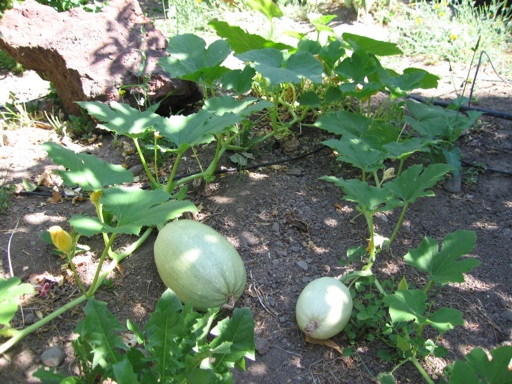
I am growing sugar pie pumpkins rather than jack-o-lantern pumpkins. I want to use pumpkins in cooking, and sugar pie pumpkins are bred for this purpose. Pumpkins are supposed to thrive in climates with relatively mild and dry summers, so they should grow reasonably well here. This is a photo of one of my pumpkin vines with a pumpkin on it:
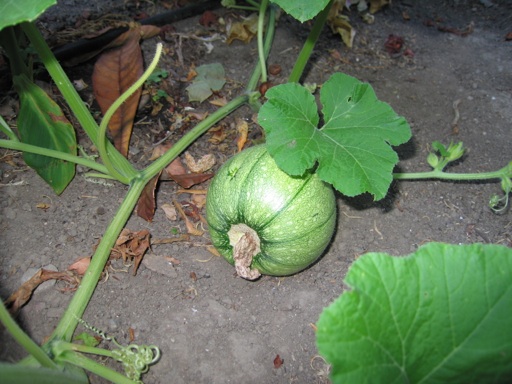
June 15 2013 | Beans and Corn and Peanuts and Pumpkin and Squash and Zucchini | Comments Off on Vegetable Assortment
« Prev - Next »




















